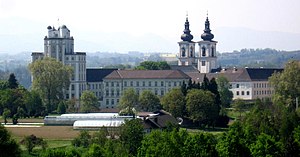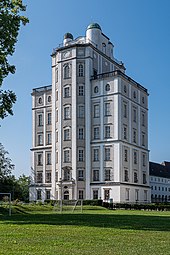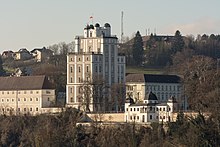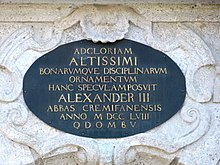Kremsmünster observatory
| Kremsmünster observatory | |
|---|---|
|
Kremsmünster Abbey, view from the northeast, on the left the mathematical tower with the observatory domes |
|
| founding | 1749 (built 1748–1758) |
| IAU code | 539 |
| Type | Astronomical tower |
| height | 382 m above sea level A. (terrain) |
| Coordinates | 48 ° 3 '18.6 " N , 14 ° 7' 53.7" E |
| place | Kremsmünster |
| operator | Kremsmünster Abbey |
| management | P. Amand Kraml (2019) |
| Website | www.specula.at |
The Kremsmünster observatory in Upper Austria ( Specula cremifanensis ) is one of the most important historical observatories in the world. It was built in 1749 as a 50 m high "Mathematical Tower" by the Benedictine Abbey of Kremsmünster on the southeast side of the abbey grounds, where the area slopes steeply towards the Krems valley and the town of Kremsmünster . The observatory, an astronomical tower, is located at an altitude of 380 to 430 m above sea level. A.
It is registered under the IAU code 539 . The observatory was important for the calculations and position determinations, which were excellent for the time. In addition to astronomical and meteorological research - the series of measurements of daily temperature and weather data is the longest in the world - important work on national surveying and geophysics was also carried out here . While observations on astronomy came to an end towards the middle of the 20th century, the measuring cellar is still a fundamental point for gravimetry and the earth's magnetic field . To this day it is the scientific workplace of the Benedictines of Kremsmünster. The lower 6 floors of the building serve as a natural history and technical universal museum over a period of 250 years.
It belongs to the listed complex of the monastery and has been declared Outstanding Astronomical Heritage by the International Astronomical Union .
Building history and astronomy
The monastery, founded in 777 , was, in addition to the religious goals of the order, the most important cultural bearer of the Traunviertel , which is why many priests also worked as scientists . Research in mathematics , geometry and astronomy was carried out in the convent as early as 1550. At the beginning of the 17th century there were even seven monks who “ often dealt with mathematics in their leisure hours ”. The first observation point as an astronomical tower was the Spindler Tower , today's bridge tower .
Johannes Kepler did not work here (the monastery owns an oil painting, the so-called Kremsmünster Kepler portrait ), but he worked in Linz from 1612 to 1626 as a landscape mathematician from Austria ob der Enns and u. a. should make a new map of the country, had connections with the pen; the then abbot Anton Wolfradt also made a contribution to the financing of the printing of the Epitome Astronomiae Copernicanae 1618 in Linz.
The forerunner of today's museum, the Mathematische Stube , was established in 1739. It contained objects from the collection of interested abbots and priests from numerous areas of natural science and humanities ( Museum Abbatis and Museum Fratrum ). In 1744, the Archduchess Maria Theresa founded an Austria-wide training center for nobles, the Knight Academy - instead of the Cevallier tour , they were to get the knowledge for their duties as landlords on site, both because of the associated outflow of money and to strengthen the North German Catholic diaspora. In this circle it was decided to build a museum and observatory of their own. While the astronomers would have liked to settle on the hilltop near Neuhof to the north, Abbot Alexander Fixelmillner decided to create it within the monastery district. The Bavarian Benedictine Abbot Anselm Desing was entrusted with the task .
In 1748 construction began on the large observatory, the mathematical tower , which, at 49 m high, is one of the first high-rise buildings in Europe. After the partial collapse of a mezzanine - in contrast to often much higher church towers , the building was much more difficult to erect because of the six load-bearing mezzanines - it was continued around 1750 with improved statics and completed in 1758. The large observation room was on the 6th floor (today the astronomical museum), surrounded by two large terraces and surmounted by three small observation domes .
With its construction designed for good observation conditions (also with regard to seeing ), it represents a significant change in observatory construction. Some observations were also made on the terrace of the sixth floor. The observatory produced a number of well-known astronomers . The most important was P. Placidus Fixlmillner , who was director of the observatory and the associated laboratories from 1762 to 1791. He constructed new types of measuring instruments , was an excellent observer (including precise localizations, star locations, Mercury, the newly discovered planet Uranus) and calculated the most precise radius of the earth's orbit ( astronomical unit ). He also worked as a musicologist and developed an easier-to-read musical notation , which, however, did not catch on. Among the Kremsmünster astronomers were members of the Academy of Sciences such as Fathers Anselm Desing and Augustin Reslhuber .
Around 1930 the observations for the astrometry were moved from the observatory dome (7th floor) for various reasons to the Stiftsgarten north of the observatory, where a large metal meridian house was built. The observatory was less involved in astrophysics, which emerged around 1860. The observation became less important in the course of the 20th century, at last only the star passage measurements were made in the meridian house, which existed until the 1970s.
Before the 1200th anniversary in 1977, the monastery and observatory were restored from around 1970 and adapted for the great Upper Austrian Provincial Exhibition in 1977. At that time, the natural science collections on the 1st to 6th floors were rearranged and designed as a universal museum. Guided tours are only offered in the summer as the building cannot be heated.
Earth sciences
A well-equipped weather station , which is still active today , has the longest uninterrupted series of measurements in the world at almost 250 years. The reliable records begin in 1796, but the ZAMG was also able to harmonize the older data in the meteorological diary, so that December 28, 1762 is given as the start of the record. Together with the data from the Vienna University Observatory, it forms an important basis for the HISTALP time series and is particularly important because it goes back well before the maximum of the Little Ice Age of the 19th century. Today's measuring point, the climate garden, is located in the convent garden towards the main building, in front of the tower.
In the 19th century, geophysics and the measurement of the earth's magnetic field also became a focus. In addition, a point of the gravity network was established and in 1895 a seismic observation point. In the basement there is a fundamental station for gravimetry operated by the University of Vienna .
In the course of the 19th century, the Austro-Hungarian surveying network was modernized and the nearby Gusterberg was chosen as the fundamental point for Upper Austria and Bohemia . The astronomical determination of coordinates , which was still difficult at the time, was carried out from Kremsmünster. In the course of a large geoid project , the observatory gave its name to the long Kremsmünster meridian arc , which stretched from Bohemia to the Adriatic Sea.
The observatory also cooperated with well-known scientists at the universities, including Simon Stampfer and Richard Schumann , and with regard to the botanical-zoological collections at various biological institutes.
literature
- Karl Mayrhofer: The Kremsmünster observatory . Sternenbote 1960/8, Vienna 1960
- Otto Wutzel : 1200 years of Kremsmünster. Guide to history, art collections and the observatory . Upper Austria State Museum, 1. – 5. Ed., 326 pages, Linz 1977
- Johann-Christian Klamt: Observatory and Museum in the Age of Enlightenment. The Mathematical Tower in the Age of Enlightenment (1749–1758). Verlag Philipp von Zabern, Mainz 1999, ISBN 3-8053-2403-0 .
Web links
- Kremsmünster Observatory, official website (specula.at)
- Kremsmünster Abbey: Museum and Gardens - News
- Kremsmünster Abbey: Observatory - Development of the permanent collection
- specula.at: Kremsmünster Observatory. - Description of the collections
Individual evidence
- ↑ a b c The biggest mistakes about the Kremsmünster observatory - a correction on the occasion of the 250th anniversary . P. Amand Kraml. March 22, 2008. Retrieved March 3, 2011.
- ↑ Johannes Kepler: Collected works . Edited by Max Caspar. Vol. VII: Epitome Astronomiae Copernicanae . Beck, Munich, 1953, p. 547
- ↑ Kremsmünster observatory. Austrian Academy of Sciences: austriaca.at (accessed February 26, 2019).
- ↑ a b c d Weblink Kremsmünster Abbey: Observatory.
- ↑ The frequent specification of 54 m should also measure the cellar.
- ↑ Weather stations and measuring devices: section Weather station in Kremsmünster Abbey. ZAMG press release, undated; Graphic Kremsmünster temperature series , ibid.
- ↑ The time series of the Clementinum Prague begins in 1775, as such it is the longest time series.
- ↑ Ingeborg Auer, Barbara Chimani, P. Amand Kraml, Silke Adler: Very early instrumental measurements in Austria 18 th century climate data in Austria, still unexploited. Poster, Central Institute for Meteorology and Geodynamics. Vienna (2013), ( pdf, zamg.ac.at ).



